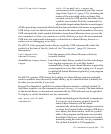To do this, use the kill command (see “Killing
the child process” (page 45)).
add-symbol-file filename
address, add-symbol-file
The add-symbol-file command reads additional
symbol table information from the file filename.
You would use this command when filename
filename address [ -readnow ]
has been dynamically loaded (by some other
[ -mapped ], add-symbol-file
means) into the program that is running.
filename address
address should be the memory address at
data_address bss_address,
which the file has been loaded; GDB cannot
add-symbol-file filename
-section address
figure this out for itself. You can specify up to
three addresses, in which case they are taken to
be the addresses of the text, data, and bss
segments respectively. For complicated cases,
you can specify an arbitrary number of
-ssection address pairs, to give an explicit
section name and base address for that section.
You can specify any address as an expression.
The symbol table of the file filename is added to
the symbol table originally read with the
symbol-file command. You can use the
add-symbol-file command any number of times;
the new symbol data thus read keeps adding to
the old. To discard all old symbol data instead,
use the symbol-file command without any
arguments.
add-symbol-file does not repeat if you press RET
after using it.
You can use the `-mapped' and `-readnow'
options just as with the symbol- file command,
to change how GDB manages the symbol table
information for filename.
section The section command changes the base
address of section SECTION of the exec file to
ADDR. This can be used if the exec file does not
contain section addresses, (such as in the a.out
format), or when the addresses specified in the
file itself are wrong. Each section must be
changed separately. The info files command,
described below, lists all the sections and their
addresses.
128 GDB Files


















